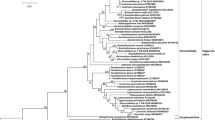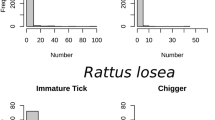Abstract
Of the eleven species of shrews described in Iran, the Etruscan shrew (Suncus etruscus), the smallest known extant mammal by mass, is recorded in northern and southern provinces. During rodent control programs, a female S. etruscus was trapped and found naturally infected with a trematode which was morphologically identified as Brachylaima sp. This finding represents the first report of trematodiasis in this host species.


Similar content being viewed by others
Data availability
All data generated or analyzed during this study are included in this published article. The original datasets are available upon request to the corresponding author.
Materials availability
All data generated or analyzed during this study are included in this published article. The original datasets are available upon request to the corresponding author.
References
Butcher AR (2016) Children, snails and worms: the Brachylaima cribbi story. Microbiol Aust 37(1):30–33
Butcher AR, Grove D (2001) Description of the life-cycle stages of Brachylaima cribbi n sp(Digenea: Brachylaimidae) derived from eggs recovered from human faeces in Australia. Syst Parasitol 49(3):211–221
Butcher AR et al (1996) Locally acquired Brachylaima sp (Digenea: Brachylaimidae) intestinal fluke infection in two South Australian infants. Med J Aust 164(8):475–478
Butcher AR, Parasuramar P, Thompson CS, Grove DI (1998) First report of the isolation of an adult worm of the genus Brachylaima (Digenea: Brachylaimidae), from the gastrointestinal tract of a human. Int J Parasitol 28(4):607–610
Debenedetti López ÁL (2015) Application of the binomial Apodemus sylvaticus/helminth as a bioindicator of the regeneration of the Serra Calderona Natural Park (Comunitat Valenciana), twenty-two years after a fire. Ph.D. thesis. University of Valencia
Dujardin F (1843) Mémoire sur les helminths des muscaraignes et en particulier sur les trichosomes, les destomes et les taenias, susr leurs métamorphoses et leurs transmigrations. Ann Sci Biol Anim 20:329–349
Etemad E (1984) The mammals of Iran, Vol. 3, Chiroptera and Insectivora. Department of the Environment, Tehran, Iran (in Persian with an English summary)
Fuentes M, Cerezuela A, Galán-Puchades M (2000) A helminthological survey of small mammals (insectivores and rodents) in the Serra Calderona mountains (Valencian Community, Spain). Res Rev Parasitol 60(1/2):23–36
Galán-Puchades MT, Mas-Coma S, Valero MA, Fuentes MV (2021) First data on the helminth community of the smallest living mammal on earth, the etruscan pygmy shrew, Suncus etruscus (Savi, 1822)(Eulipotyphla: Soricidae). Animals 11(7):2074
Guisantes J, Benito A, Estibalez J, Mas-Coma S (1994) High parasite burdens by Brachylaima (Brachylaima) sp (Trematoda: Brachylaimidae) in two dogs in the north of Spain. Res Rev Parasitol 54(4):255–258
Hall MC (1929) Arthropods as intermediate hosts of helminths. Smithsonian Miscellaneous Collections, Washington
Hanski I (1984) Food consumption, assimilation and metabolic rate in six species of shrew (Sorex and Neomys). Ann Zool Fenni 21:157–165
Heidari Z (2016) Study on helminthic parasites of domestic and wild canines of North Khorasan Province, northeast Iran with special reference to zoonotic species and genetic variety in Genus Echinococcus. Ph.D. thesis. Tehran University of Medical Sciences
Joyeux C, Foley H (1930) Les helminthes de Meriones shawi shawi Rozet dans le nord de L’Algérie. Bull Soc Zool Fr 55:353–374
Jürgens KD (2002) Etruscan shrew muscle: the consequences of being small. J Exp Biol 205(15):2161–2166
Karimii M, Hutterer R, Benda P, Siahsarvie R, krystufek B (2008) Annotated check-list of the mammals of Iran. Lynx (praha) Series Nova 39(1):63–102
Mahmoudi A, Darvish J, Pehpuri A, Saeidzadeh S (2017) New data on distribution and taxonomy of the genus Suncus (Mammalia: Soricidae) in Iran; molecular evidence. Iran J Anim Biosyst 13(2):229–235
Mas-Coma S, Fons R, Galan-Puchades M, Valero M (1984) Hymenolepis claudevaucheri n. sp. (Cestoda: Hymenolepididae), first record of a helminth in the smallest known living mammal, Suncus etruscus (Savi, 1822)(Insectivora: Soricidae). Critical revision of the Cyclophyllidea in Suncus murinus (Linnaeus, 1766). Vie Molieu 34:117–126
Mas-Coma S, Fons R, Galan-Puchades M, Valero M (1986a) Hymenolepis banyulsensis n sp (Hymenolepididae) un nouveau Cestode parasite de la Musaraigne étrusque (Soricidae) dans la région de Banyuls-sur-Mer (France). Rev Suisse Zool 93(2):329–339
Mas-Coma S, Fons R, Galán-Puchades M, Valero M (1986b) Description of Hymenolepis cerberensis n. sp.(Cestoda: Hymenolepididae) and first general considerations on the fauna of cestode parasites of the pygmy shrew Suncus etruscus (Savi, 1822)(Insectivora: Soricidae). Ann Parasitol Hum Comp 61(4):411–422
Mobedi I, Fakhar M, Irshadullah M, Rahimi-Esboei B, Gholami S, Fraija-Fernandez N (2017) New record of Brachylaima sp (Digenea: Brachylaimidae) from a stray dog in North Iran. Iran J Parasitol 12(4):606
Mohtasebi S, Teimouri A, Mobedi I, Mohtasebi A, Abbasian H, Abbaszadeh Afshar MJ (2020) Intestinal helminthic parasites of rodents in the central region of Iran: first report of a capillariid nematode from Dryomys nitedula. BMC Res Notes 13(1):1–7
Segade P, Crespo C, García N, García-Estévez J, Arias C, Iglesias R (2011) Brachylaima aspersae n. sp (Digenea: Brachylaimidae) infecting farmed snails in NW Spain: morphology life cycle pathology and implications for heliciculture. Vet Parasitol 175(3–4):273–286
Sirgel WF, Artigas P, Bargues MD, Mas-Coma S (2012) Life cycle of Renylaima capensis, a brachylaimid trematode of shrews and slugs in South Africa: two-host and three-host transmission modalities suggested by epizootiology and DNA sequencing. Parasites Vectors 5(1):1–18
Wilson DE, Reeder DM (2005) Mammal species of the world: a taxonomic and geographic reference, vol 1. JHU press, Baltimore
Yamaguti S (1958) Systema Helminthum. Vol. I. The digenetic trematodes of vertebrates-part II. Systema Helminthum Vol I The Digenetic Trematodes of Vertebrates-Part II. New York
Yousefi A, Eslami A, Rahbari S, Mobedi I (2017) Parasitic infections of bicoloured white-toothed shrew (Crocidura leucodon) from Dasht-e-Razan. Western Iran Iran J Parasitol 12(1):123
Acknowledgements
The authors express profound gratitude to the late Professor Iraj Mobedi for his invaluable collaboration in writing this finding, without which the identification of our samples would not have been possible.
Author information
Authors and Affiliations
Contributions
FN drafted the manuscript and performed the parasitological techniques. SM carried out the dissection, morphological and taxonomical identification, and figure illustration. GM performed sample collection, preservation, and descriptive issues. DO, GM, and SMC conceived and designed the study and reviewed the final manuscript. All authors read and approved the final manuscript.
Corresponding authors
Ethics declarations
Ethics approval
This sample was captured accidentally during an authorized rodent pest control program that was done under the Ahvaz City municipality regulations in the late 1990s. Due to the delayed trap collection, we confronted the dead carcass.
Consent to participate
Not applicable.
Consent for publication
Not applicable.
Conflict of interest
The authors declare no competing interests.
Additional information
Handling Editor: Una Ryan
Publisher’s note
Springer Nature remains neutral with regard to jurisdictional claims in published maps and institutional affiliations.
Rights and permissions
Springer Nature or its licensor holds exclusive rights to this article under a publishing agreement with the author(s) or other rightsholder(s); author self-archiving of the accepted manuscript version of this article is solely governed by the terms of such publishing agreement and applicable law.
About this article
Cite this article
Najafi, F., Mowlavi, G., Mohtasebi, S. et al. First evidence of Brachylaima sp. (Diplostomida; Brachylaimidae) infesting the Etruscan shrew (Suncus etruscus) in Iran. Parasitol Res 121, 3597–3601 (2022). https://doi.org/10.1007/s00436-022-07684-4
Received:
Accepted:
Published:
Issue Date:
DOI: https://doi.org/10.1007/s00436-022-07684-4




